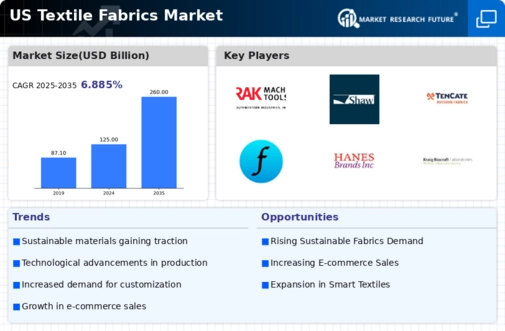The textile fabrics market in the US is characterized by a dynamic competitive landscape, driven by innovation, sustainability, and technological advancements. Key players such as Burlington Industries (US), Milliken & Company (US), and DuPont (US) are actively shaping the market through strategic initiatives. Burlington Industries (US) focuses on sustainable practices, emphasizing eco-friendly materials and processes, which aligns with the growing consumer demand for environmentally responsible products. Milliken & Company (US) has positioned itself as a leader in innovation, investing heavily in research and development to create high-performance fabrics that cater to diverse applications. Meanwhile, DuPont (US) leverages its extensive portfolio to enhance product offerings, particularly in the areas of performance textiles and smart fabrics, thereby reinforcing its competitive edge.
In terms of business tactics, companies are increasingly localizing manufacturing to reduce lead times and enhance supply chain efficiency. This approach not only mitigates risks associated with The textile fabrics market demands. The market structure appears moderately fragmented, with several key players exerting influence while also facing competition from smaller, niche manufacturers. The collective strategies of these major companies contribute to a robust competitive environment, fostering innovation and driving market growth.
In November 2025, Milliken & Company (US) announced a partnership with a leading tech firm to develop smart textiles that integrate wearable technology. This strategic move is significant as it positions Milliken at the forefront of the growing smart fabric segment, potentially opening new revenue streams and enhancing its market presence. The collaboration underscores the importance of technological integration in textile applications, aligning with consumer trends towards multifunctional products.
In October 2025, DuPont (US) launched a new line of sustainable fabrics made from recycled materials, reflecting its commitment to environmental stewardship. This initiative not only addresses the increasing consumer preference for sustainable options but also enhances DuPont's brand reputation as a responsible manufacturer. The introduction of these fabrics is likely to attract environmentally conscious consumers and strengthen DuPont's market position.
In September 2025, Burlington Industries (US) expanded its production capabilities by investing in advanced manufacturing technologies. This investment aims to streamline operations and improve product quality, which is crucial in a competitive market where differentiation is key. By enhancing its manufacturing processes, Burlington is poised to respond more effectively to customer needs and market trends.
As of December 2025, the textile fabrics market is witnessing a shift towards digitalization, with companies increasingly adopting AI and automation to optimize operations. Sustainability remains a central theme, influencing product development and consumer preferences. Strategic alliances are becoming more prevalent, enabling companies to leverage complementary strengths and enhance their competitive positioning. Looking ahead, the competitive landscape is likely to evolve, with a pronounced shift from price-based competition to a focus on innovation, technology integration, and supply chain reliability. This transition suggests that companies that prioritize these aspects will be better positioned to thrive in the future.





















Leave a Comment